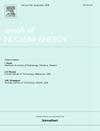Systematic generation of effective thermophysical and thermo-mechanical properties for reduced-order modeling of TRISO fuel pellets
IF 1.9
3区 工程技术
Q1 NUCLEAR SCIENCE & TECHNOLOGY
引用次数: 0
Abstract
This work presents a detailed methodology for generating effective material properties of tri-structural isotropic (TRISO) fuel pellets for use in reduced-order homogenized thermal and/or mechanical calculations. This is achieved by use of the finite-element (FE) method to perform simulations of explicitly modeled TRISO fuel pellets, in conjunction with derivation of analytical equations for analogous homogenous pellets which preserve a particular parameter of interest. This method is applied to several properties including thermal conductivity, specific heat capacity, thermal expansion coefficient, Young’s Modulus and Poisson’s Ratio. The properties generated are a function of temperature and packing fraction. It is demonstrated that the state-of-the-art for homogenizing thermal conductivity may be inadequate for realistic TRISO pellets, while for other properties existing homogenization standards are scarce in the literature. Finally, a multi-physics application of the reduced-order properties is demonstrated, which involves coupling neutronics with thermo-mechanical calculations. The fission power distribution is obtained from neutronic analysis, and then temperature, displacement and stress–strain distributions from the explicit finite-element model are compared with those from the homogenous calculations. For the finite-element simulations, the commercial software Abaqus (ABAQUS, 2014) is used, and the Monte Carlo code MCNP is used for neutronics to obtain the power distributions.
系统生成有效的热物理和热机械性能,用于TRISO燃料颗粒的降阶建模
本研究提出了一种生成三结构各向同性(TRISO)燃料颗粒有效材料特性的详细方法,可用于降阶均质热和/或机械计算。具体方法是使用有限元(FE)方法对明确建模的 TRISO 燃料颗粒进行模拟,同时推导出保留特定相关参数的类比均质颗粒的分析方程。该方法适用于多种属性,包括热导率、比热容、热膨胀系数、杨氏模量和泊松比。生成的属性是温度和堆积分数的函数。研究表明,最先进的热导率均质化技术可能无法满足实际 TRISO 球团的需要,而对于其他属性,现有的均质化标准在文献中很少见。最后,演示了还原阶属性的多物理场应用,其中涉及中子学与热力学计算的耦合。通过中子分析获得裂变功率分布,然后将显式有限元模型的温度、位移和应力应变分布与同质计算的温度、位移和应力应变分布进行比较。有限元模拟使用了商业软件 Abaqus(ABAQUS,2014 年),中子学则使用蒙特卡罗代码 MCNP 来获得功率分布。
本文章由计算机程序翻译,如有差异,请以英文原文为准。
求助全文
约1分钟内获得全文
求助全文
来源期刊

Annals of Nuclear Energy
工程技术-核科学技术
CiteScore
4.30
自引率
21.10%
发文量
632
审稿时长
7.3 months
期刊介绍:
Annals of Nuclear Energy provides an international medium for the communication of original research, ideas and developments in all areas of the field of nuclear energy science and technology. Its scope embraces nuclear fuel reserves, fuel cycles and cost, materials, processing, system and component technology (fission only), design and optimization, direct conversion of nuclear energy sources, environmental control, reactor physics, heat transfer and fluid dynamics, structural analysis, fuel management, future developments, nuclear fuel and safety, nuclear aerosol, neutron physics, computer technology (both software and hardware), risk assessment, radioactive waste disposal and reactor thermal hydraulics. Papers submitted to Annals need to demonstrate a clear link to nuclear power generation/nuclear engineering. Papers which deal with pure nuclear physics, pure health physics, imaging, or attenuation and shielding properties of concretes and various geological materials are not within the scope of the journal. Also, papers that deal with policy or economics are not within the scope of the journal.
 求助内容:
求助内容: 应助结果提醒方式:
应助结果提醒方式:


